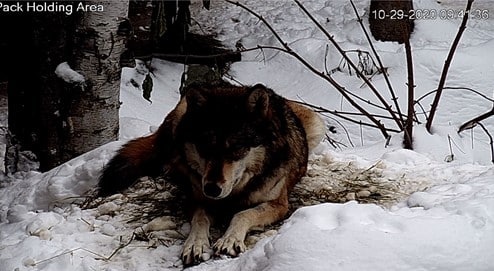Boltz Update 29 October 2020
The last log referenced some tests that run on the spinal fluid sample that was collected on October 15th. All of the samples came back negative, except some back negative, except some bacteria was identified on the aerobic culture. The lab reran the sample and determined that the aerobic culture were bacterial isolates due to contamination.
While we await the DNA test to see if Boltz carries a mutated gene associated with Degenerative Myelopathy (DM), we proactively started Boltz on a vitamin protocol recommended by the University of Florida study on Degenerative Myelopathy in dogs. Our intention was to strengthen his immune system as we go through this diagnostic process. We are seeing the results in a very sleek, thick winter pelage, making him look extremely healthy. Through this entire process, Boltz remains alert, has a great respiration rate, a good appetite and doesn’t appear to show a pain response. All appearances show a healthy wolf, but he just has no strength in his back legs to support himself and is frequently falling. We put him back on Prednisone, but his condition has been so challenging because he has good days and bad days and despite a significant amount of video correlations, it is hard to pin point if the prednisone is working. We can honestly say that there is no significant improved response with prednisone, but it could be helping, so we are keeping him on a low dose right now. We have ruled out all of the potential issues except DM and a remote chance that this is a disease called Myasthenia Gravis. Some of the symptoms are voice changes (BZ lost his high pitch howl over 2 years ago with no definitive issues noted with an endoscope of his throat ) progressive weakness and exercise-related collapse. These symptoms fit Boltz condition, especially the collapse with more movement.
Our vet just treated a dog for myasthenia and it was 100 percent improved with 4 days of treatment, and response to treatment was pretty much immediate. To diagnose this condition, a blood draw is typically required. We have chosen not to put him through the stress of the blood draw. There was less risk in starting him on the treatment than to do an immobilization in these cooler, wet temperatures. While we have reversible drugs that would be out of his system in an hour, there is also a risk of Boltz panicking during the injection and injuring himself in this vulnerable state. We are also concerned about Boltz’s negative association with staff that need to care for him during this critical time. So, today is the start of the treatment. If it is Myasthenia Gravis, we will have good news to report over the weekend.




